Dec 25, 2025
Dec 25, 2025
Continued from “The Splendors of Shiraz”
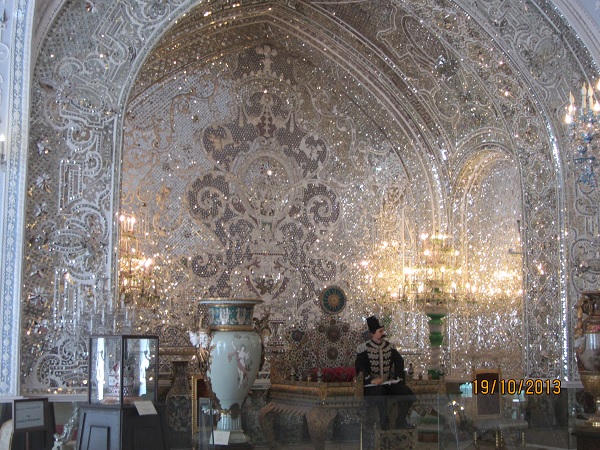
Tehran is a fairly young city compared to other cities in Iran with barely 200 year old history. If Isfahan is hailed as the majestic capital city of Iran during the Safavid period, Tehran, with all its intricacies and delicacies in architecture, culture and art, was the capital city of the Qajar Dynasty and enjoys significant importance in its transition from the past to the present.
It was Karim-Khan Zand of Zand dynasty who had considered making Tehran his capital. However, he later changed his mind and made Shiraz his capital instead. Upon Karim-Khan's death in 1779, Aqa-Mohammad-Khan fled from Shiraz to Gorgan, where he established the Oajar tribe. With their help, he prepared the occupation of northern Iran. In 1785 AD, he set out towards Tehran, which was still under the domination of the remnants of the Zand dynasty. A year later, in 1786 AD, Tehran fell to Aqa-Mohammad-Khan. One of the wishes of Agha Mohammad Khan was, to be officially crowned, so that no one would deny his rule nor would anyone remain in opposition. He held a very ceremonious coronation in Tehran. But, about a year later, he was assassinated in the Caucasus by his attendants. His relatively short political life was mostly spent in fighting.
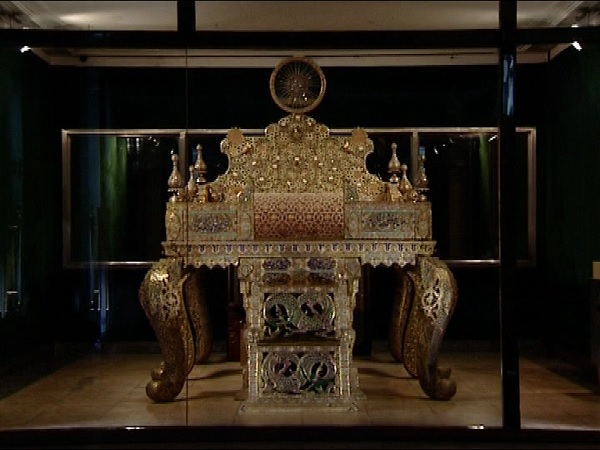
Peacock Throne (Sun Throne) of Fath ’Ali Shah at Treasury of National Jewels
His successor, Fath-’Ali Shah, who was quite interested in the appearances of glory and power of kingship built many new palaces: the Negarestan Palace and Gardens, the Lalehzar Palace, the Golestan Palace, the Oajar Palace and the Soltani (Royal) Mosque. After the downfall of the Qajar dynasty and the coming to power of the Pahlavi dynasty, along with other alterations in the social, economic and political affairs in Iran, Tehran also underwent major changes, most of which was novel and modernizing projects reflecting the new civilization rapidly developed in Tehran.
The majority of these projects were continued after the Islamic revolution of 1979 under the spiritual leadership of Ayatollah Khomeini when Tehran’s urbanization had reached its peak, and the new government started many other new projects, such as the Milad Tower. Iran, though under the grip of sanctions, still enjoy a remarkable quality of life compared to many nations in the Middle East. It is successfully on its path to become a self-reliant and industrious nation in every walk of life.
Here are some of the interesting monuments and museums that I could manage to visit during my stay in Tehran
National Museum of Iran
National Museum of Iran is barely 70 years old and I must say a visit to this museum is sine qua non for any human being interested in the evolution of man. It harbors over 300,000 artifacts belonging to Lower and Upper Paleolithic period, Neolithic age, Chalcolithic and Bronze age including all Pre-Islamic Persian civilizations and dynasties of Iran. It is not only the largest museum of History and Archaeology of the country, but ranks as one of the few most prestigious museums of the world in regard to the grand volume, diversity and quality of its exhibits. In the Iranian museum tradition it is considered Iran’s mother museum, aiming at preserving relics of the past to hand down to the next generations, enhancing better understanding among world peoples and nations, discovering and showing Iranian’s roles in shaping world culture and civilization and trying to enhance public knowledge.
The range of items on display in this museum is breathtaking. What attracts any visitor here is the aesthetic and creative diversity of craftsmen who belonged to this part in the 4th -7th millennium BC. The amazingly delightful clay and ceramic pottery of vases, pitchers, drinking pots, cups, colorful glazed bricks decorated with double-winged mythical creatures and vessels in animal shapes make us marvel at the inventive genius of our ancients.
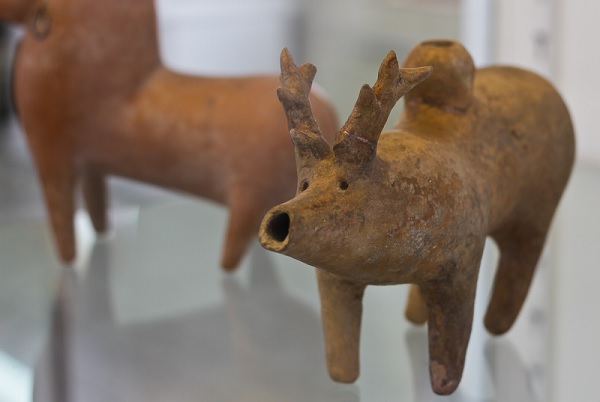
An animal figure made out of clay. So cute!
It may be that after discovery of metals, man further developed his civilization and used objects made of copper, bronze, gold and silver in the form of rings, bars, square or round pieces, or as knife and axe as means of barter trading. Farming began in the Middle East around 12,000 years ago, making possible the social, cultural and economic changes which shaped the modern world.
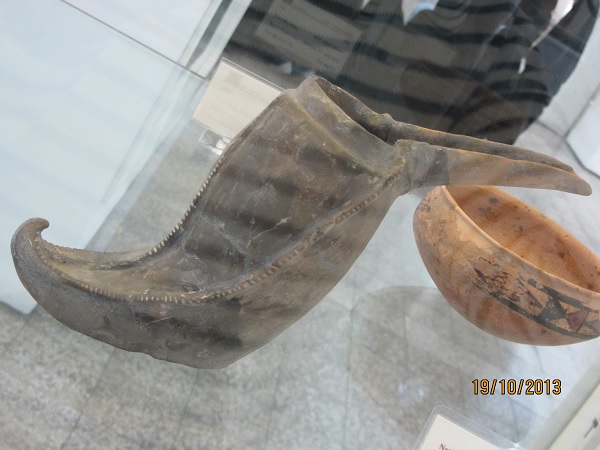
A pitcher in the shape of a shoe
There is an excellent section on Persepolis which displays Archaemenian period reliefs from Persepolis. One section has the great staircase with the nobles bringing tributes to the Persian King. Also displayed is a façade depicting Darius I seated on throne with the nobles in front and Xerxes and the generals behind the king. Darius and Xerxes are holding the Lotus flower sign of Royalty and everlasting life.
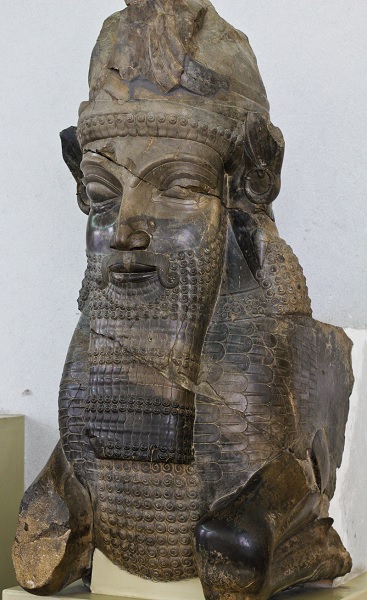
Archaemenian period relief: Bull with a bearded man's head
One fascinating display piece that has attracted crowd is the ‘Saltman’. In the winter of 1993, miners came across a body with long red hair and a beard, and associated artifacts, in the Chehrabad salt mines located to the west of the city of Zanjan, Iran. They found the remains of a body, a lower leg still inside a leather boot, three iron knives, a pair of woolen trousers, a silver needle, sling, parts of a leather rope, a grindstone, and even a walnut. The body had been buried in a tunnel approximately 45 meters in length. After archeological studies which included C14 dating of different samples of bones and textiles, the Salt Man was dated to about 1,700 years ago. By testing a sample of hair, the blood group B+ was determined. The display says he was around 37 when he died.
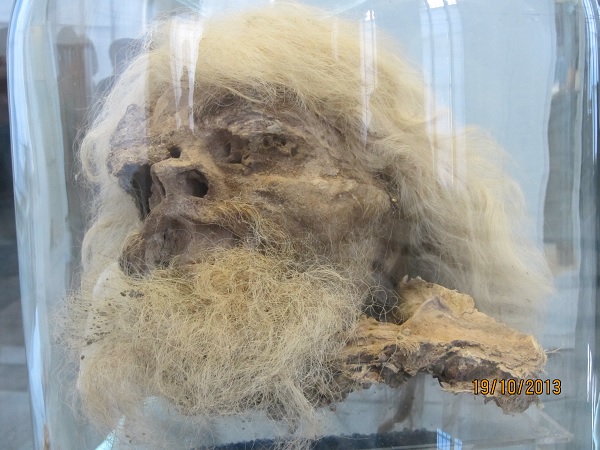
The head of the saltman who died 1700 years ago
Treasury of National Jewels
The imperial crown jewels of Iran on display in the National Jewels museum constitute the largest jewelry collection in the world and no wonder it is the biggest tourist attraction in Tehran. Here is the most dazzling collection of gemstones and jewelry ever known in the world. Every collection here is a reflection of the tumultuous history of this great nation, and the result of creativity and artistry of the residents of this land. Each piece recalls memoirs of bitter-sweet victories and defeats, of pride and arrogance of rulers who were powerful or weak.
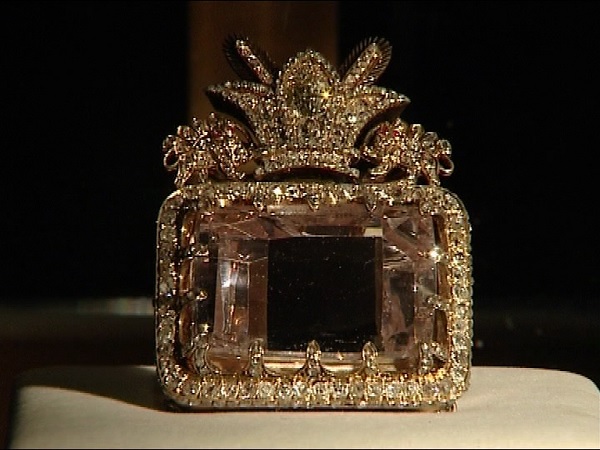
The famous Darya-ye Nur (Sea of Light)-The largest uncut diamond in the world
Owned by the Central Bank and housed underneath the central branch of Bank Melli, this museum is perhaps the most guarded single terrain in Iran. One has to undergo many levels of security checks before we get a glimpse of the sea of jewels on display here including the famous Darya-ye Nur (Sea of Light), a pink diamond weighing 182 carats and said to be the largest uncut diamond in the world. Other important highlights in this museum are the Peacock (Naderi) Throne, the tall Kiani Crown made for Fath’-Ali Shah in 1797, the crowns worn by the last shah and his wife, Farah and the incredible 34kg Globe of Jewels, made in 1869 using 51,366 precious stones – the seas are made from emeralds and the land from rubies (with Iran, England and France set in diamonds)
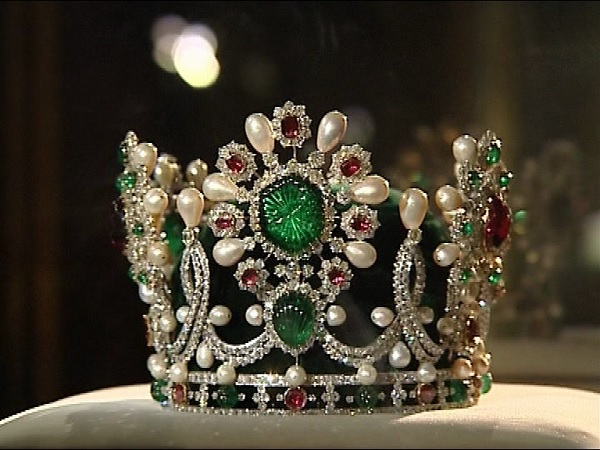
The crown of Empress Farah Pahlavi
Most of the collection dates back to Safavid times, when the shahs scoured Europe, India and the lands of the Ottoman Empire for booty with which to decorate the then capital, Esfahan. However, when Mahmud Afghan invaded Iran in 1722, he plundered the treasury and sent its contents to India. On ascending the throne in 1736, Nader Shah Afshar dispatched courtiers to ask for the return of the jewels. When their powers of persuasion proved unequal to the task, he sent an army to prove that he was serious. To get the soldiers off his back, Mohammed Shah of India was forced to hand over the Darya-ye Nur and Kuh-e-Nur diamonds, a Peacock Throne (though not the one you’ll see here) and other assorted treasures. After Nader Shah’s murder in 1747, Ahmed Beg plundered the treasury and dispersed the jewels.
The Peacock Throne (Sun Throne) displayed outside the Jewelry museum in a separate enclosure was built during the reign Fath’-Ali Shah and was named after his favorite wife Tavous Khanoom or Lady Peacock.
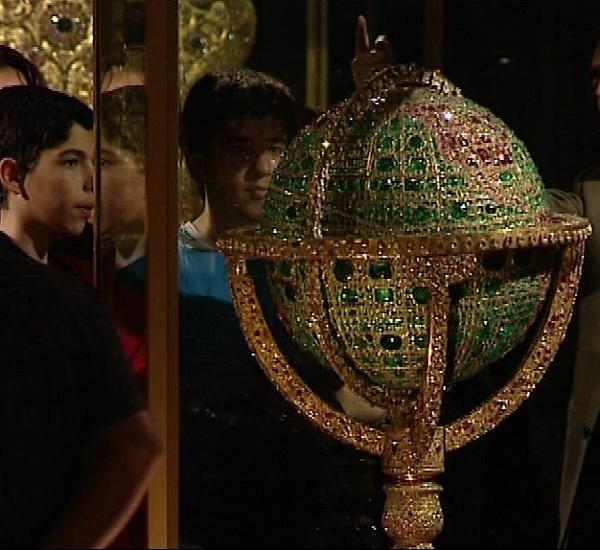
34kg Globe of Jewels using 51,366 precious stones
Other collection includes numerous plates, ewers, aigrettes (hat ornaments), bejeweled water pipes, and other dining services cast in precious metals and encrusted with gems, and several other more unusual items (such as a gemstone globe) collected by the Iranian monarchy during its 2,500-year existence. No photography is allowed here and hence I had to buy a CD to capture images.
Golestan Palace
The lavish Golestan Palace is a masterpiece of the Qajar era, embodying the successful integration of earlier Persian crafts and architecture with Western influences. The walled Palace, one of the oldest groups of buildings in Teheran, became the seat of government of the Qajar family, which came into power in 1779 and made Teheran the capital of the country. Built around a garden featuring pools as well as planted areas, the Palace’s most characteristic features and rich ornaments date from the 19th century. It became a centre of Qajari arts and architecture of which it is an outstanding example and has remained a source of inspiration for Iranian artists and architects to this day. It represents a new style incorporating traditional Persian arts and crafts and elements of 18th century architecture and technology.
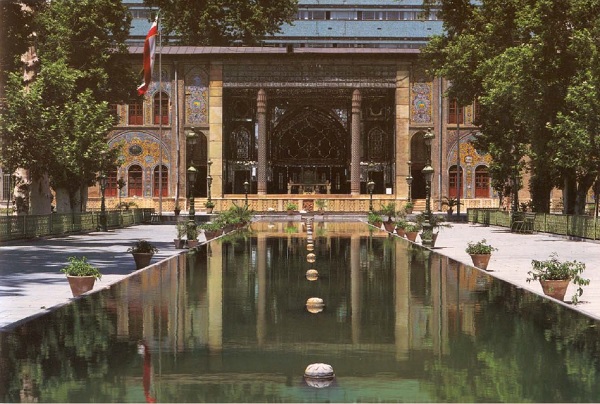
Golestan Palce
In its present state, Golestan Palace is the result of roughly 400 years of construction and renovations. The complex consists of 17 palaces, museums, and Halls. This entire complex was built mainly during 200 years of Qajar kings ruling.
Golestan Palace has witnessed many historical events during the last two centuries and holds many unspoken secrets. Once it was the gem of the historical Arg of Tehran and is now a memorial to the old glory of the royal citadel. The Arg was built during the reign of Shah Tahmasp I (r. 1524-1576) of the Safavid dynasty (1502–1736), and was later renovated by Karim Khan Zand (r. 1750-1779). The Court and Golestan Palace became the official residence of the royal Qajar family. The palace was rebuilt to its current form in 1865 by Haji Abol-hasan Mimar Navai.
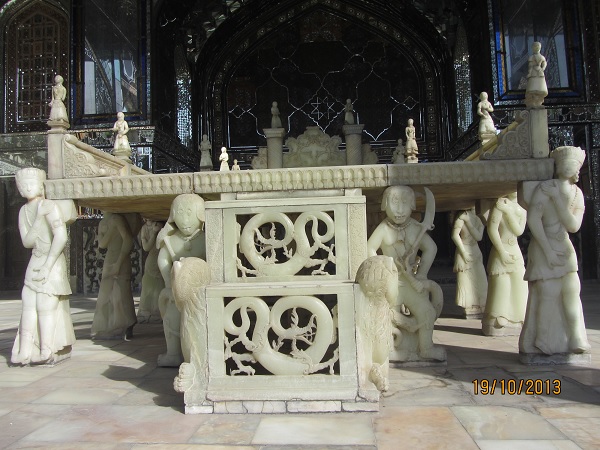
Marble throne Veranda
Right at the entrance of this palace is the Marble Throne Veranda, a mirrored, open-fronted audience hall dominated by a magnificent throne. The throne is supported by human figures and constructed from 65 pieces of yellow alabaster from mines in Yazd. It was made in the early 1800s for Fath’-Ali Shah, a monarch who managed a staggering (and quite likely very tiring) 200-odd wives and 170 offspring. This hall was used on ceremonial occasions, including the Napoleon-style self-coronation of Reza Shah in 1925.
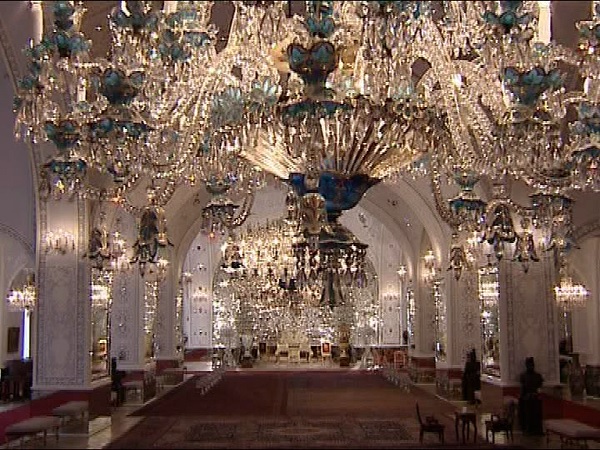
Hall of mirrors in Golestan palace
There are two particular areas in this palace complex that one shouldn’t miss: the Hall of Mirrors and the Hall of Diamonds. Both are known for their stunning mirror work and ornamentation. Hall of Mirrors is one of the most famous halls of Golestan Palace. It was built simultaneously with Reception Hall between 1874 and 1877. This hall was dedicated to the Peacock Throne and the Kianid Crown when the objects in the old museum were taken to the new museum, The Hall of Diamonds was built in the early 1800s but got modified later on – is made up of the main hall with side rooms and corridors.
Carpet Museum of Iran
Carpet-weaving is undoubtedly one of the most distinguished manifestations of Iranian culture and art, dating back to the Bronze Age. But as the materials used in carpets including wool and cotton, decay into dust during the course of time, archaeologists couldn’t make any special discovery during the archaeological excavations. However, radiocarbon testing of ancient carpet pieces reveals that the art of carpet-weaving in Iran is at least 3500 years old. Carpet-weaving is undoubtedly one of the most distinguished manifestations of Iranian culture and art.
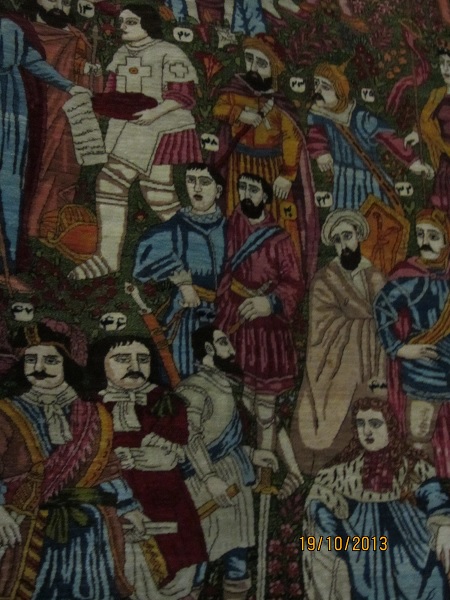
Motif on a 17th century carpet in Carpet Museum, Tehran
In 1978, the founders of the Carpet Museum of Iran established this Museum with a limited number of Persian carpets and kilims, in order to revive and develop the art of carpet-weaving in the country, and to provide a source to satisfy the need for research about the historical background and evolution of this art. The Carpet Museum of Iran, with its beautiful architecture and facade resembling a carpet-weaving loom is located on the northwest of Laleh Park in Tehran. It is composed of two exhibition galleries covering an area of 3400 m2.The collection of carpet museum comprises of samples of Iranian carpets from the 9th century AD up to the present. About 135 master pieces of Iranian carpets are displayed in the ground floor.
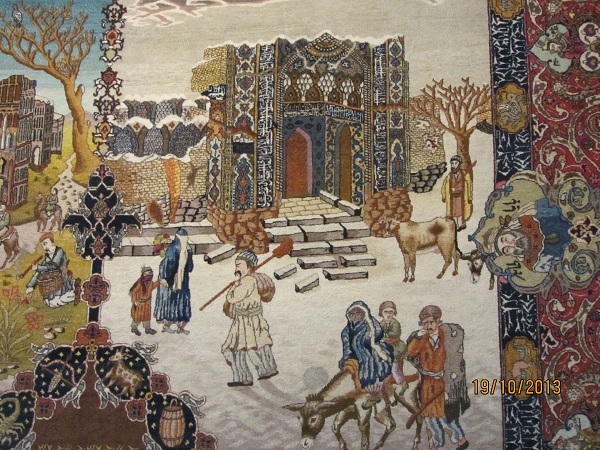
Pattern in another Persian carpet
The interior of this museum has a serene setting. We are immersed in the rich the patterns and beautiful motifs seen in the rugs on display here and some still look bright and beautiful even after 400 years. Some of the 17th Century rugs like the Tabriz Garden design carpet had panels of trees and stylized flowers divided by irrigating water channels. Intricate ripples in the water are cleverly designed by repeated arches in black and white. The main patterns seen in these carpets include historic monuments and Islamic buildings, spiral patterns, tree patterns, hunting ground patterns, panel patterns, flower patterns, vase patterns, intertwined fish patterns, Mehrab patterns, striped patterns, geometric patterns, tribal patterns etc.
Glassware & Ceramic Museum of Iran, Tehran
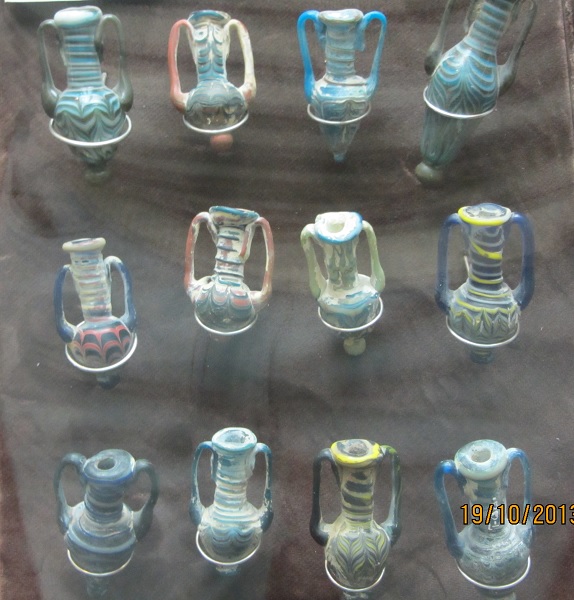
Ancient perfume bottles
The impressive Glass & Ceramics Museum is housed in a beautiful Qajar-era building. Built as a private residence for a prominent Persian family, it later housed the Egyptian embassy and was converted into a museum in 1976. The building marks a move away from purely Persian traditions, successfully blending features of both Eastern and Western styles. The graceful wooden staircase and the classical stucco moldings on the walls and ceilings are particularly delightful, and there are many delicate carvings and other decorations.
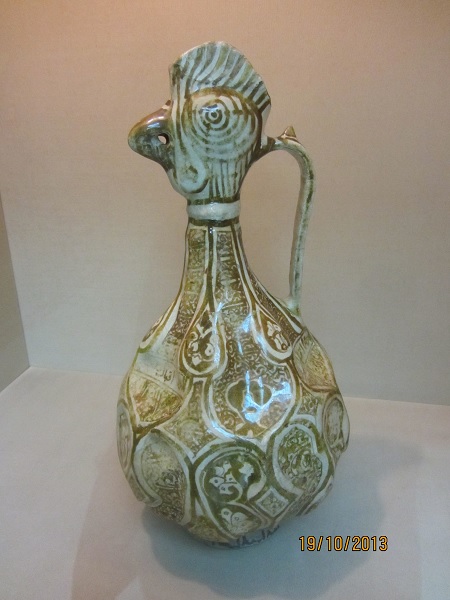
A beautiful ceramic ware on display
The museum itself is modest in its range but there are hundreds if exhibits from Neishabur, Kashan, Rey and Gorgan, dating from the 2nd millennium BC. They’re organized chronologically into galleries, with explanations of the periods in English, plus other relevant details such as the Persian glass-blowing tradition. The museum is full of beautiful and fascinating glasses like ancient perfume bottles, chinaware and ceramics.
Tehran Museum of Contemporary Art
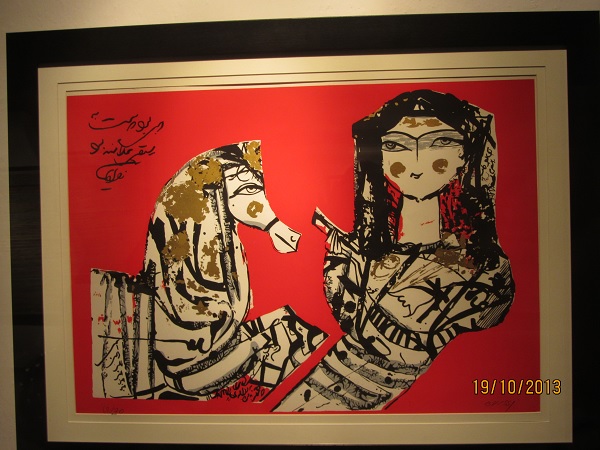
Qajar woman by Naser Oveisi
Inaugurated in 1977, and built adjacent to Tehran’s Laleh Park, the museum was designed by Iranian architect Kamran Diba, who employed elements from traditional Persian architecture. The museum holds arguably the greatest collection of Western art in Asia – worth between US$2 billion and US$5 billion. Contrary to preconceptions of Iran, here’s a collection of art (not always modern and rarely contemporary) by Iranian artists and some of the biggest names of the last century. The exhibits were mostly of Iranian artists at the time of my visit though I heard that it has collection of many masters like Picasso, Matisse, Van Gogh, Miró, Dali, Bacon, Pollock, Monet and Warhol.
Concluding Note on Iran
My seven days sojourn in Iran has helped to discover the true identity of this marvelous nation blessed with rich historic, cultural and linguistic heritage. As Will Durant rightly said in his famous speech “Persia in the History of civilization”:
“For thousands of years Persians have been creating beauty. Sixteen centuries before Christ there went from these regions or near it — from Aryana Vaieho, or Old Iran—the migration that poured new blood into northern India. From that new blood came the noble Sanskrit language, so nearly kin to your own melodious speech; from that fusion came the Vedas, the Upanishads, and Buddha. You have been here a kind of watershed of civilization, pouring your blood and thought and art and religion eastward and westward into the world. From the Avesta of your ancient faith came not only a hundred influences upon Judaism, Christianity, and -Muhammadanism, but one of the highest moral philosophies of all time — the conception of life as struggle between light and darkness, truth and falsehood, good and evil, and the command to men to enlist in the fight for light, and help Ahura Mazda win that great battle whose cosmic scope and vast duration gave to the individual life a meaning, a value, and a nobility that could not be crushed by death.”
The Persian empire founded by Cyrus the Great in the 6th century BC and conquered by Alexander the Great in 328 BC have since then undergone a cycle change of many empires. The Invaders have included the Turks, Genghis Khan and the Mongols, and, most significantly, the Arabs who conquered the ancient Persian Empire in the seventh century and brought a period of Moslem greatness that was distinctly Persian. Iranians seem particularly proud of their capacity to get along with others by assimilating compatible aspects of the invaders’ ways without surrendering their own – a cultural elasticity that is at the heart of their Persian identity. The tree in Iran has very deep roots.
It is interesting to note that when invaders came to Iran, the Iranians did not become the invaders; the invaders became Iranians. Their conquerors were said to have “gone Persian,” like, Alexander the Great, who, after burning Persepolis and conquering Persia, adopted Iran’s cultural and administrative practices, took a Persian wife (Roxana) and ordered thousands of his troops to do the same in a mass wedding.
In the August 2008 issue of the National Geographic Shirin Ebadi, the Iranian lawyer who won the 2003 Nobel Peace Prize said:
“When I go abroad, people are surprised when they realize that 65 percent of the college students here are girls. Or when they see Iranian paintings and Iranian architecture, they are shocked. They are judging a civilization just by what they have heard in the last 30 years. The media has portrayed the Islamic revolution in a negative way; the rollbacks of personal freedoms, particularly for women; the nuclear program and antagonism with the West. They know nothing of the thousands of years that came before – what the Iranians went through to remain distinct from their invaders, and how they did it. For example, after the Arabs came, and Iran converted to Islam, eventually we turned to the Shiite sect, which was different from the Arabs, who are Sunni. They were still Muslims, but not Arabs.”
Many modern Iranians still, at least in part, identify with their Persian roots. There are traces of the life-loving Persian nature that is good food, love, hospitality, poetry, music and celebration of life woven into the fabric of Islam – it’s like a secret undercurrent quietly running in the background. You cannot really separate the Iranian identity as one thing or the other, because it is part Persian, part Islamic, and part Western. But there is a Persian identity that has nothing to do with Islam, which at the same time has blended with the culture of Islam.
It is gratifying that though the nation is still moored in a mire of muddled politics, the people of this primordial nation are knotted beautifully like one iridescent Iranian rug.
10-Nov-2013
More by : P. G. R. Nair